11 Best first-time Europe itineraries for 1, 2, or 3 weeks
Europe is going to be very busy in the summer of 2024 as the world is back to normal and travel demand is higher than ever. One other key factor is that most European currencies are still hovering at lower levels historically compared to the US dollar, which means that Europe will feel somewhat cheap again this year. In fact, according to our World Backpacker Index, European cities like Lisbon, Madrid, and Munich are about 30% cheaper to visit than Boston, Chicago, and New York City. In other words, flying to Europe might seem expensive, but most things will be cheaper once you get there compared to the costs of visiting a large US city.
Below you’ll find 11 of the most popular and best itineraries for a first visit to Europe. Your first visit is not really the time to be different or creative, and the famous destinations tend to be popular for a reason. In other words, it’s kind of silly to visit, say, Bulgaria, if you’ve not yet been to France or Italy. I lay out the best options along with how long to stay in each place as a general guide. I also discuss Mediterranean cruises, which can actually be an amazing way to see a lot of Europe on your first visit, especially if you don’t like going back and forth to train stations and airports every 2 or 3 days.
For a bit of fun you might be interested in the cheapest 5-star hotels in Europe, which start at US$80 per night for really nice hotels. It helps show that if you choose some of the cheaper cities, you can treat yourself to some luxury that you can’t afford in most other places.
This article was last updated in March, 2024.
There are 11 starter itineraries described in detail below
- Classic London and Paris
- England and Scotland
- Paris and Italy
- Mediterranean cruise
- France, Belgium, and Netherlands
- Paris and elsewhere in France
- Italy
- Spain
- Germany
- Switzerland
- Best of cheap eastern Europe
For each itinerary there are suggestions of other destinations that are easy to add on to the main cities.
Note: This article was most recently updated in March, 2024
Building the best itinerary for your first trip to Europe
Below there are 11 popular itineraries for one week in Europe. If you’ve only got a week then choose one of them and assume you’ll return again to conquer more of this amazing part of the world. If you’ve got more time then you can choose from some of the top add-on suggestions for each one.
Start in the most famous cities
Your first visit to Europe is no time to try to be different or edgy. I recommend that you focus on these 5 great cities before you start branching out into cheaper or more obscure places.
Keep your travel days to a minimum
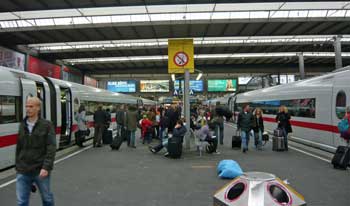
Spend 3 (or 4) nights in almost every major city
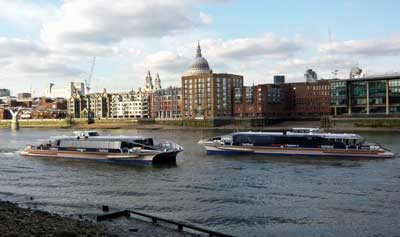
So many first-time visitors are initially planning on spending only 1 or 2 nights in major cities that I wrote a detailed explanation of why 3 nights is ideal for almost all European cities, even if you want to see as much as possible.
3 (or 4) nights will be enough for any city on your first trip
Most first-time visitors are tempted to move too quickly, but it can also be a mistake to move too slowly. It’s really amazing how much you can see in two full sightseeing days. If you spend too long in one city you’ll end up seeing things that are way down your list, while you could be in another city seeing things at the top of your list there.
Choose cities that are easy to reach from each other
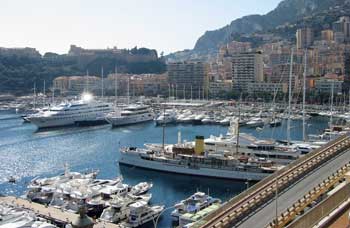
For your first trip it’s best to visit cities that are no more than a 5-hour train ride apart.
Choose cities that are connected by reasonable train rides rather than flights
To build on the point above, finding cheap flights within Europe is easy, but train travel is about a million times more enjoyable and less stressful. You’ll enjoy the train rides almost as much as the cities, so focus on places that are within 5 hours of each other by train.
Start with one of the classic itineraries below, and then add to it if you have more time
If you only have 7 days then you’ll find a list below of classic itineraries that are well-suited to a first visit to Europe. Hopefully you have more than 7 days though, and if you do you can add in one or more of the suggested add-on cities to build an itinerary that appeals most to you.
Best 1-week itineraries for the first time in Europe
Itinerary 1: Classic London and Paris
Fly into either city and take the 2-hour Eurostar train between them
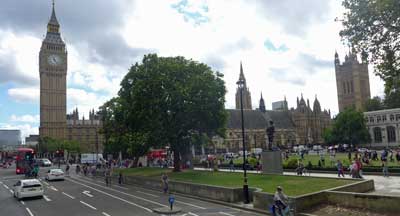
London highlights
- Big Ben and Parliament
- Westminster Abbey and St. Paul’s Cathedral
- Tower of London and Tower Bridge
- West End shows (Broadway equivalent) and classic pubs
- Buckingham Palace and Windsor Castle
Paris is actually far more beautiful than London and the food is famously much better as well. Since Paris gets so many tourists from non-French speaking countries, it’s easy to get by on just English, and the Metro system makes it fast and easy to get around. The architecture of both cities is amazing from the Tower of London, Big Ben, Westminster Abbey to the Louvre and the Eiffel Tower. These cities each pack a huge punch and they are very different from each other as well. Actually, England is arguably the best choice for your first trip to Europe.
Paris highlights
- Eiffel Tower
- Louvre Museum and Museum de Orsay
- Arc de Triomphe and other monuments
- Montmartre neighborhood and Sacré Coeur Cathedral
- Probably the world’s best affordable restaurants and wine
Best add-ons to London and Paris
- Edinburgh (2 or 3 nights, from London)
- Amsterdam (2 or 3 nights, from Paris)
- Bruges and Brussels (2 nights, from Paris)
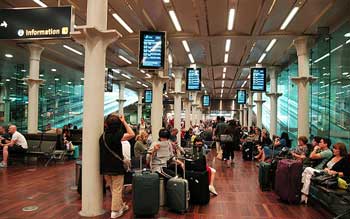
>>>Best one-week London and Paris itinerary in detail
>>>Check London hotel deals
>>>Check Paris hotel deals
Itinerary 2: England and Scotland
- London (3 or 4 nights)
- York (1 night)
- Edinburgh, Scotland (2 or 3 nights)
- Inverness, Scotland (2 or 3 nights)
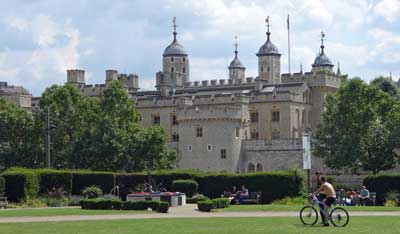
York is a small Roman city with intact city walls and one of the most famous cathedrals in Europe. Edinburgh is not only the capital of Scotland, but it’s easily the second most interesting city in all of Britain. If your time is short, skip York and spend more time in Edinburgh.
If you prefer to focus on the south of England on your first trip then the best option is to go to Bath or nearby Bristol after London. Bath is another of England’s top destinations and it’s a gorgeous city that has been a spa resort for many centuries. It’s also reasonably close to Stonehenge. You can also easily get to Cornwall in England’s southwest corner from Bath, and that’s a whole different and fascinating experience (with nicer weather than up north).
If you’ve got more than a week and want to spend more time in Scotland, especially in the summer months, the place to head to is Inverness. It’s a small town that is considered the gateway to the Scottish Highlands, but it’s an interesting and charming place on its own. You can take day-trips by bus to the highlights of the Highlands including the Isle of Skye and Loch Ness. Between you and me, it’s better to minimize time in Loch Ness or skip it altogether because it’s not one of the more photogenic parts of Scotland and the monster has always been a hoax.
Travel times between the recommended places
- London to York by train: 2 hours
- York to Edinburgh by train: 2.5 hours
- London to Edinburgh by train: 4 hours
- Edinburgh to Inverness by train: 3.5 hours
- London to Bath by train: 85 minutes
Best add-ons to England and Scotland
If you think you want to spend your whole trip in Britain you should have a look at our article on the best itineraries in England, Scotland, and Wales.
>>>Check London hotel deals
>>>Check Edinburgh hotel deals
Itinerary 3: Paris and Italy
- Paris (3 or 4 nights)
- Venice (1 night)
- Florence (2 or 3 nights)
- Rome (3 nights)
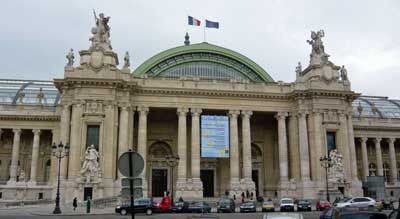
From Paris you can easily fly to Venice (or nearby Treviso) where you should try to spend about 24 hours. Venice is small enough to see in a full day, and so crowded that most people are satisfied to leave after that day. The key is to stay in the main part of the main island so you can enjoy Venice before the cruise passengers and day-trippers arrive, and also after they leave for the day. Two nights in Venice would not be wasted time, and it’s possibly the most gorgeous city in the entire world, but you can see the best of it in a bit over 24 hours.
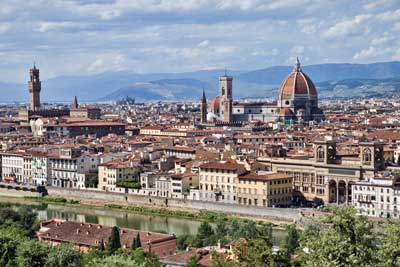
Rome also lives up to the hype and spending a day in the Vatican City will be a highlight even for non-Catholics, but it’s also a crowded and busy city so three days is usually enough for most people. Similar to Paris, Rome is an unusually beautiful city from almost any angle when you are in the historical center. You’ll walk through a stunning piazza (town square) and then turn a corner and you’ll see gorgeous buildings or public statues that are as nice as anything in the museums. Seriously, it’s worth a visit.
Paris to Venice flight: 1 hour 35 minutes
Venice to Florence by train: 1 hour 53 minutes
Florence to Rome by train: 1 hour 16 minutes
You can of course instead fly from Paris to Rome and then go north to Florence and then to Venice and fly home (or back to Paris) from there, and it would be just as enjoyable.
Best add-ons to Paris and Italy
France
- Nice/Cannes/Monaco (2 or 3 nights)
- Avignon (2 nights)
- Bourges (2 nights)
- Bordeaux (2 nights)
- Aix-en-Provence (2 nights)
- Reims (2 nights)
- Dijon/Burgundy (2 nights)
Italy
- Milan (1 or 2 nights)
- Lake Como (2 nights)
- Siena (2 nights)
- Cinque Terre (1 night)
- Naples/Sorrento/Amalfi Coast/Pompeii/Capri (3 to 5 nights)
- Sicily (3 to 4 nights)
>>>Much more information in this article about the best France and Italy itineraries
>>>Check Paris hotel deals
>>>Check Venice hotel deals
>>>Check Florence hotel deals
>>>Check Rome hotel deals
Itinerary 4: Mediterranean cruise
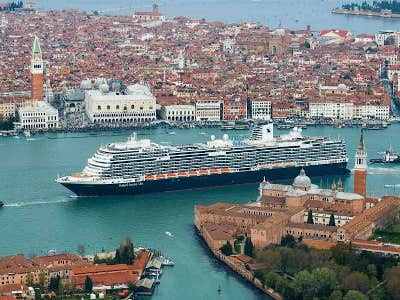
In spite of the reputation of cruises to be floating buffets, they can actually be an excellent way to visit a great number of amazing European cities in a short time. The ship typically is in port from the early morning until mid evening, often giving you the opportunity to have dinner in the city (unlike Caribbean cruises). Better still, the cruise ports are often near the center of town, so you can just walk off the ship and do sightseeing on foot or by public transportation.
Mediterranean cruises usually start at 7 nights but can go up to 3 weeks, which can provide an amazing tour of the entire region without having to pack and repack your bags more than once. They also can provide excellent value, especially compared to the price of taking trains or flights and finding new hotels in every destination.
Most popular Mediterranean departure ports
Barcelona, Spain – It’s an easy port to reach. Ships generally go from Barcelona with stops in France and then Italy.
Rome (Civitavecchia), Italy – The port isn’t very close to Rome, but it’s easy to get back and forth. Ships go west to France and Spain as well as south around the tip of Italy and then on to Croatia, Venice, and to Greece.
Venice, Italy – The cruise ships no longer dock close to the best tourist areas, but it’s easy enough to visit Venice for a day or two before boarding a ship. Ships starting in Venice go south and then head west and to Rome and then to France, or they go south to Croatia and then head east to Greece.
Athens, Greece – The cruise port of Piraeus is just south of Athens and easy to reach. Ships from Athens usually head west towards Croatia, Italy, France, and Spain, but there are also ships that visit Greek islands and Turkey.
>>>Check for deals on Mediterranean cruises
Alternative to consider: a river cruise
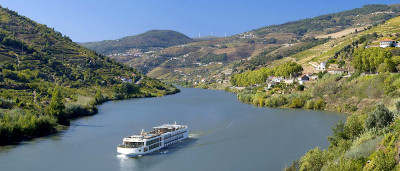
Amsterdam, Budapest, and Prague are some of the most popular river cruise ports, but there are dozens of others including many smaller towns in France where few other tourists will be when you stroll off the ship. There is little or no entertainment on the river cruise ships, but passengers don’t miss it because the entire day and into the evening is spent just steps from local cultural offerings and restaurants.
>>>Check for Europe and river cruise deals
Itinerary 5: France, Belgium, and Netherlands
Paris to Brussels: 1 hour 22 minutes
Brussels to Bruge: 58 minutes
Bruges to Amsterdam: 2 hours 45 minutes
Amsterdam to Paris: 3 hours 17 minutes
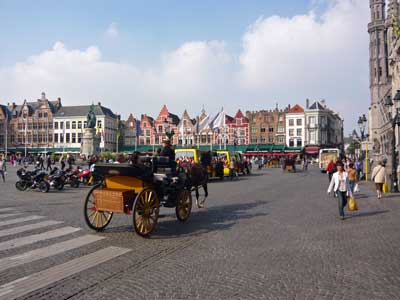
Spending 4 nights in Paris and 3 nights in Amsterdam would be a great trip, but if you want to see something else you’ve got a couple options in between. My advice is to spend an afternoon looking around the Grand Place (main square) in Brussels and then hop a 58-minute train ride to Bruges for a night or two. Brussels isn’t a great tourist city, but Bruges really is so it’s a better option for most people. Whatever you choose out of this group, you can be back in Paris on another high-speed train for your flight home.
Best add-ons to France, Belgium, and Netherlands
- Luxembourg City (1 or 2 nights)
- Cologne, Germany (1 or 2 nights)
- London (3 or 4 nights)
- Interlaken, Switzerland (2 or 3 nights)
>>>Check Paris hotel deals
>>>Check Bruges hotel deals
>>>Check Amsterdam hotel deals
Itinerary 6: Paris and elsewhere in France
- Paris (3 or 4 nights)
And a choice of:
- Nice/Cannes/Monaco (2 or 3 nights)
- Avignon (2 nights)
- Bourges (2 nights)
- Bordeaux (2 nights)
- Aix-en-Provence (2 nights)
- Reims (2 nights)
- Dijon/Burgundy (2 nights)
- Normandy (2 nights)

While Nice is a wonderful tourist city for a look at the French Riviera, the other larger cities of Lyon and Marseilles are probably better saved for a future trip because they are light on key sights compared to many smaller towns. Wine lovers can rent a car or take trains into Bordeaux or Burgundy. Since you can get between most of these towns by train in 2 hours or less, spending only 2 nights in each one is a reasonable option if you want to see a lot in a short time.
Normandy is an interesting choice and easy to reach in only about two hours by train from Paris. Some visitors like to see the famous WWII beaches and memorials, while others (especially in summer) like to check out one or more of the beach-resort towns. Deauville is one of the more famous of those, and it’s also famous for its horse race track and as one of the epicenters of the industry in Europe.
Best add-ons to Paris and elsewhere
- More France, of course
- London (3 or 4 nights)
- Interlaken, Switzerland (2 or 3 nights)
- Amsterdam (2 or 3 nights)
>>>Check Paris hotel deals
>>>Check Nice hotel deals
Itinerary 7: Italy
Rome to Florence: 1 hour 16 minutes
Florence to Venice: 1 hour 53 minutes
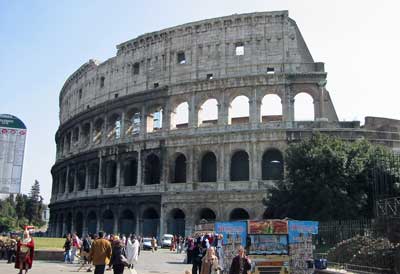
Venice is small enough that you can see the main sights in about 24 hours, and it’s so insanely crowded that many people tire of it after about a day as well. It’s better to pay more for a hotel to be on the main island and visit quickly than to save money with a hotel on the mainland where you’ll be in crowds going back and forth as well. Florence is the most relaxing of the 3, and also a great base for side trips to Pisa, Siena, and Cinque Terre, just to name a few.
Going to Italy? Here are the best first-time Italy itineraries for 3 days to 2 weeks (in much greater detail)
Best add-ons to Italy
- Milan (1 or 2 nights)
- Lake Como (2 nights)
- Siena (2 nights)
- Cinque Terre (1 night)
- Naples/Sorrento/Amalfi Coast/Pompeii/Capri (3 to 5 nights)
- Sicily (3 to 4 nights)
>>>Check Rome hotel deals
>>>Check Florence hotel deals
>>>Check Venice hotel deals
Itinerary 8: Spain
Madrid to Barcelona: 2 hours 30 minutes
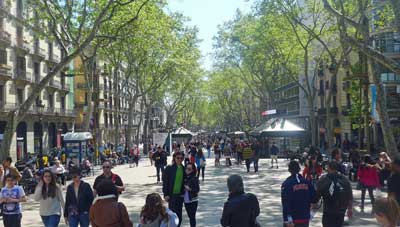
A huge part of Spain’s tourism industry is built around its southern beaches and islands such as Ibiza, Mallorca, and Tenerife (in the Canary Islands). For most people it’s best to ignore those places on your first trip because none of the beaches are special enough to spend days on them compared to the culture of the cities.
Best add-ons to Spain
By popular demand, I’ve added a full article on where to go in Spain with itineraries from 7 to 10 days up to two weeks.
>>>Check Madrid hotel deals
>>>Check Barcelona hotel deals
>>>Check Lisbon hotel deals
Itinerary 9: Germany
Berlin to Munich: 6 hours 2 minutes
Munich to Rothenburg ob der Tauber: 2 hours 56 minutes
Munich to Füssen: 2 hours 4 minutes
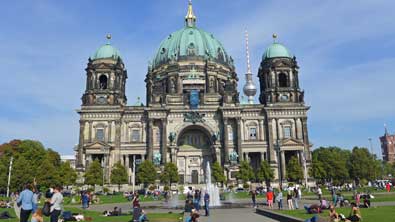
Those two cities are the keys to a Germany visit, and after that you’ve got a wide variety of choices. I cover most of the popular choices in my article on where to go in Germany, which covers several smaller towns that are major highlights.
Best add-ons to Germany
- Cologne (1 or 2 nights)
- Hamburg (2 or 3 nights)
- Amsterdam (3 nights)
- Prague (3 nights)
- Salzburg (2 or 3 nights)
- Vienna (3 nights)
- Interlaken, Switzerland (3 nights)
- Lucerne, Switzerland (2 or 3 nights)
>>>Check Berlin hotel deals
>>>Check Munich hotel deals
Itinerary 10: Switzerland
- Interlaken (3 nights)
- Bern (1 night)
- Lucerne (3 nights)
Zurich Airport to Interlaken: 2 hours 10 minutes
Interlaken to Bern: 53 minutes
Bern to Lucerne: 1 hour 50 minutes
Lucerne to Zurich Airport: 1 hour 3 minutes
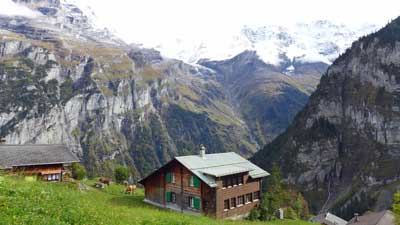
Interlaken is the best hub for the most dramatic Alps views and experiences. The one-hour cable car ride up to the Schilthorn observation deck is something you’ll never forget, and the only thing that might be more dramatic is the train ride up to the Jungfraujoch station, which is the highest in Europe. Lucerne is almost as beautiful with a scenic lake at its heart and also great mountaintop views nearby. If you do want to see a Swiss city then the capital of Bern is the most interesting and photogenic on a short visit. Read more about where to go in Switzerland for even more ideas.
Best add-ons to Switzerland
>>>Check Interlaken hotel deals
>>>Check Lucerne hotel deals
Itinerary 11: Eastern Europe’s best cheap cities
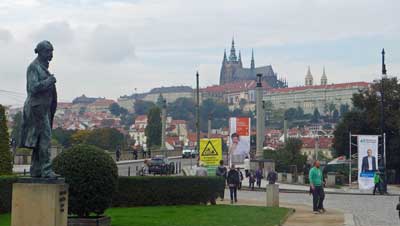
Each of these cities is beautiful and historic, but English is less widely spoken so they can also be quite a bit more challenging for a first-time visitor. Another difficulty is that the trains between them are still quite slow compared to the high-speed rail in the West, so it takes most of a day from one to another, and a bus is often a better choice. I cover this best cheap Europe itinerary more fully in the linked article.
Prague to Budapest: 6 hours 41 minutes
Budapest to Krakow: 9 hours 54 minutes (flying might be better)
Best add-ons to cheap Eastern Europe
- Cesky Krumlov, Czechia (2 nights)
- Ljubljana, Slovenia (2 or 3 nights)
- Split, Croatia (3 nights)
- Belgrade, Serbia (2 or 3 nights)
- Sarajevo, Bosnia and Herzegovina (2 or 3 nights)
- Sofia, Bulgaria (2 or 3 nights)
>>>Check Prague hotel deals
>>>Check Budapest hotel deals
>>>Check Krakow hotel deals


Thank you, thank you, Roger. Advice happily received and will be duly pondered. :-]
Hi Roger,
This is an amazing post! Thanks for such great tips. Can you please guide ne with ny itenary as. At the momen i am clueless ok which part is best for me. I an planning a 2 week trip with my retired parents and 4yr old toddler in May. We definately have to do London for 3-4 nights as we have friends there but other than that i cant decide the rest. This is our first europ trip and i am quite concufsed in choosing between famous cities Like Paris. Switzerland, Venice, Germany, Italy. Since i have to manage my parents and my son both i wanted to know places which would be common for both age groups and less hectic for me. Also i was planning to Hire a car for transport but i can see you mentioned trains are better. Is there any particular train ride which js best and rest of the time i can drive as I am sure intercity drives would be scenic too.
Looking forward to hear from you.
Thanks
Neeru,
I’m happy to try to help. First off, if you are going between major European cities it’s almost always best to take trains. A car can be an economical way of getting around for groups of 4 people, but the main problem is finding parking. Parking in big European cities is always expensive and sometimes it’s not even available in the city center where the tourist attractions are located. On the other hand, the train stations are all very central and all the cities have good and inexpensive public transportation, so getting around town is fast and easy once you are there. You’d never want to drive a car around, say, London or Paris to go from one sight to another because it would cost a fortune to park at each place.
I think a 4-year-old would probably ride trains free with a paid adult and your retired parents should be able to get reduced-fare train tickets, so it won’t be too bad. Since you are going in May as long as you buy the train tickets by the end of March they should be pleasantly cheap.
Okay, so you’ll stay 3 or 4 nights in London and after that you should take the Eurostar train to Paris in a bit over two hours. Stay in Paris for 3 or 4 days and you’ll have gone the first week without needing a car. For a first-time Europe trip the most popular way to spend the next week would be to fly to Venice and spend 1 or 2 days there and then a short train ride to Florence for 2 or 3 nights and then a short train ride to Rome for your final 3 nights.
All of those places will be very popular with all ages. London and Paris are filled with big sights such as the London Eye and Eiffel Tower, and Italy has food that everyone loves as well as gelato shops that keep young ones motivated.
The other possible great option would be to go to Switzerland after Paris. Switzerland has the most amazing scenery in Europe, but it’s also very expensive and it would cut down on the time you have for Italy, so I’d probably recommend saving it for a future trip. I’m happy to help more if you have other questions. -Roger
Hi Roger, I’m happy to find your site!
Four almost-retirement-age friends are planning the following. Our goals are Paris (a friend lives near) and Salamanca, Spain, where a daughter is in school. What do you think? Too much driving? We have a flex day available besides these.
arrive Paris from US–4 nights
drive to Interlaken–2 nights
drive to Florence–1 night
drive to Rome–4 nights
drive to Cinque Terre–1 night
drive to Narbonne, France–2 nights
drive to Barcelona–1 night
train to Salamanca to meet others–4 nights
Madrid–1 night to fly home
Ruth,
Normally I do everything I can to discourage people from driving between European cities like this, but with 4 adults riding together it can actually make financial sense and give you MUCH more flexibility, so it’s really down to the parking challenges. Most of Europe is set up to make driving and parking difficult and encourage public transportation. In fact, you’d almost certainly find trains more enjoyable and they wouldn’t cost much more if you buy your tickets at least a month or two in advance.
Interlaken is pretty car friendly though. In Florence and Rome you’ll have to pay a LOT to park the car near the city center where the sights are, AND of course you’d never want to drive the car for sightseeing so it would just stay parked until you are ready to leave town. In Cinque Terre the parking lots are quite a ways from the towns, but there are shuttle buses from the parking lots from what I’ve read. I haven’t been to Narbonne, France, but it looks pretty rural so parking might not be too difficult.
Aside from the mode of transport I’d probably recommend staying 2 nights in Florence and only 3 nights in Rome. Rome has more big sights, but it’s also very hectic and most people get tired of it pretty quickly after seeing the main things. Florence is more mellow and easier to deal with, and it has loads of great sights and food. Barcelona and Madrid are both large cities with loads of great sights and they are very different from each other. I normally recommend 3 nights in each of them as a minimum, so in just one night you’ll only get the quickest taste and you’ll miss almost all of the best things. I hope this helps and let me know if you have any other questions. -Roger
Thank you for your reply. 🙂 Switzerland it is! Is this your recommended direction of things?
I would fly London ( 2 or 3 nts Roger?) – eurostar to Paris ( 3 nts)- train to Switzerland ( 2 nts)-train to Venice ( 1 nt..where to stay again?) via Interlaken – Is there a train to Florence? Recommend a different city? 3 nts there, then train to Rome 3nts… fly back to San Francisco
My husband keeps wanting to leave London off the list 🙁 I just saw Mary Poppins and I want to go even more!. If we do start in Paris ( actually cheaper flight than Londen), what city would you add after Rome?
Thank you Roger. I feel my hand held!
Sheryl,
Yes, your itinerary looks great. I’d stay 3 nights in London if you go there and you could do just 2 nights in Florence if you don’t have enough days.
In Venice I’d recommend staying on the main island, and hopefully a hotel fairly close to St. Marks Square, which is the heart of the sightseeing area. That area isn’t cheap, but for one night it’s worth a mini splurge because it puts you in the middle of the action and you can explore Venice in the evening and the morning when the cruise passengers and day trippers aren’t around.
The train from Venice to Florence only takes 1 hour 53 minutes. If you save London for a future trip I’d spend another night in Switzerland, at least 3 nights in Florence, and maybe another night in Venice. If you wanted to add something beyond Rome the obvious choice would be Naples or Sorrento, but I’d save those for a future trip. From Florence you can do day trips to Pisa and Siena and the Cinque Terre in addition to some lovely nearby hill towns, so that is a great base for a longer stay to see a lot of classic Italy, and I’d recommend that over Naples and Sorrento for this trip. Let me know if you have any other questions. -Roger
Hi Roger
Happy new Year!
Your site is amazing and very helpful!
I was doing research on my impending euro trip in June/July 2019 for two weeks and landed on your site.
It would be great if you can help me plan the cities I should travel to as this will be my second trip to the continent. I had a similar trip in June 2014 and visited Interlaken, Prague, Budapest, Zagreb/Plitvice and 7 days in Italy visiting Rome, Venice, Florence and Cinque Terre and flew home back from Milan.
I would love to travel again to East Europe covering Dubrovnik, Split, Lake Bled, Salzburg, Hallstatt, Warsaw however I would be repeating countries. Should I explore somewhere else in Europe like maybe Amsterdam, Bruges, Paris, Spain and Portugal.
Could you please suggest keeping in my mind the places I have already visited?
Awaiting your reply.
Khushboo,
I answered this question a bit above, so here it is again:
You’ve been to some amazing cities and some of Europe’s best scenery already, so well done. If your budget will allow it I would recommend going to some different cities that are also among the most interesting. I’ve got another article on this site discussing what I consider to be Europe’s 5 greatest cities to explore before the others. Spoiler alert: the list is London, Paris, Amsterdam, Rome, and Venice. Since you’ve already done Rome and Venice I’d highly recommend putting Paris and Amsterdam onto the list for this trip, and maybe even London. All three of those cities really do live up to the hype and they are very different from each other and from any other city.
Bruges is actually like a small and mellow version of Amsterdam so I’d probably save it for a future trip. If you also want to go to Spain I’d start with Barcelona and Madrid, which are both very different and very worthwhile. If you have time to include Portugal then a visit to Lisbon would be great as well. I’m happy to help more so let me know if you have any other questions. -Roger
Hi Roger! Happy New Year!
Traveling in September, part of 6 ( 80 to 20 years). Based on your suggestions 🙂
Nailing down the details of travel and cities!
Fly to London OR Amsterdam 2 or 3 nts?? Eurostar to Paris 3 nts , train to Switzerland ( or Amsterdam?)- 2 nts, train to Venice-1 nt, train to Florence – 3nts, train to Rome- 3nts. Fly home from Rome?
Let me know your thoughts. Also very interested in your lodging suggestions?
thanks so much
Sheryl,
Happy New Year to you! And I’m glad you’ve found the site useful. Your itinerary looks fantastic and I think any of your options would work well, so it’s mainly down to which places sound the best to you. London and Amsterdam join Paris, Venice, and Rome on my top 5 cities in Europe list, so I’m sure you’ll love either one.
Either way I think I’d recommend Switzerland instead of Amsterdam in the middle for a few reasons. Those big cities you’ll be visiting are all wonderful, but they’ll seem even nicer if you have a scenery break in the middle, and Switzerland has the best scenery in Europe. Also, the train trip from Interlaken to Venice is amazing by itself, so that’s a much nicer option than flying from Amsterdam to Venice.
As for lodging suggestions, I have articles with recommended hotels in each city that are linked on the city page, such as this one for Paris. At the very least you can see which neighborhoods I recommend and why. That said, for a party of 6 you might want to look into Airbnbs and other apartments instead of hotels. Hotel rooms all over Europe are quite small compared to most of the rest of the world, so you’d not only need 3 rooms in each city for 6 people, but there usually isn’t even enough room for 6 people to chat in a typical double hotel room, much less sleep. The main downside of Airbnbs in cities like this is that the ones with really convenient locations tend to be very expensive. Still, with 6 people if you can find a rental with 3 bedrooms or 2 bedrooms and a sofa-bed or two, it should still be cheaper than 3 hotel rooms and it will allow you to make a few meals and save a bit more money, and also be large enough for the whole group to chat in the same living room.
My general advice for Europe will still apply in that I think it’s better to pay more for a central location and a smaller place than to try to save money by booking a place outside of town. I speak out of experience (and being a cheapskate for many years) that it’s not worth it to save US$20 per night per person and then have to spend an hour or two on buses going in and out of the city. Being able to have dinner at a nice restaurant near your hotel in the tourist area will enhance your experience a lot. As always, let me know if you have any questions. -Roger
Hi Roger,
Happy new year! My friends and I will be doing our elective in Newcastle and we are planning to tour around Europe during our Easter vacation (around 2 weeks). We are actually quite lost in picking the countries to travel since this is our first time but there are a few that we really want to visit like Italy and Paris. Can I have your recommendations on how we can utilize our holidays to the maximum? And we would appreciate if it’s a budget friendly one.
Koh,
That sounds like a great opportunity. If you’ve got two weeks I’d definitely start in Paris. From Newcastle it’s probably best to fly because it would take quite a while to take a train down to London and then the Eurostar to Paris. I’d spend 3 or 4 nights in Paris and after that I’d go to at least one more place in France. Nice is a great choice because it’s a lovely city that is also a short train ride from Monaco and Cannes. You could spend about 3 nights there and then take trains to Venice for one or two days to start your Italy visit.
Venice is small enough to enjoy in about 24 hours, and so crowded that 24 hours is enough for most people. It’s also quite expensive. After Venice you could take the short train ride to Florence for 2 or 3 nights and then another short train ride to Rome for your final 3 nights. Then you could fly from Rome back to Newcastle or Edinburgh or whichever airport works best.
Pretty much all of this information and more is in my article about the best France and Italy itineraries for 2 to 3 weeks. Obviously there are many other places you can go, but even if you hadn’t mentioned France and Italy this is what I would have suggested for the best first visit to continental Europe. Especially in March or April, most of the rest of Europe is still pretty chilly and you’ll enjoy warming up a bit in Italy. Let me know if you have any other questions. -Roger
Thanks Roger for the prompt response.
I understand your point, so I would drop Itally off the list completely. But I am not sure in April end what’s best to visit, Spain Italy or the cities I picked! The primary reason of keeping Berlin and Paris from the beginning was I knew a few friends.
But I wished to include Barcelona or some of Andalusia in the trip as well, so if you’d suggest dropping any of the city I picked and include Any other from Spain, I can totally do that.
Also if there is any particular website that you could recommend, for booking all the train tickets within Europe and economic stays/dorms, it would be really helpful too.
Thanks! -Pallavi
Pallavi,
Italy is wonderful for first-time visitors because the highlights are really world class, while I think the main sights in Spain aren’t quite as interesting. Spain is a bit cheaper and also more pleasant because it’s less crowded, but Spain can also be challenging because so few people speak English. I’m sure you’ll enjoy wherever you go.
As for booking train tickets for Europe it’s best to book online, in advance, from the official websites of the various countries. All of that information and links to the national rail companies are in this article whether you should book European train tickets in advance.
For booking hostels your best choice is probably Hostelworld. I have links to recommended hostels on the various pages of this site such as the Europe Backpacker Index, which lists 56 cities from cheapest to most expensive. There used to be a few competitors, but Hostelworld bought them and now they have by far the largest inventory. That said, they do have an easy to use website and their prices are good as well, even if there is a small booking fee. -Roger
Hi Roger
Happy new Year!
I was doing research on my impending euro trip in June/July 2019 for two weeks and landed on your site.
It would be great if you can help me plan the cities I should travel to as this will be my second trip to the continent. I had a similar trip in June 2014 and visited Interlaken, Prague, Budapest, Zagreb/Plitvice and 7 days in Italy visiting Rome, Venice, Florence and Cinque Terre and flew home back from Milan.
I would love to travel again to East Europe covering Dubrovnik, Split, Lake Bled, Salzburg, Hallstatt, Warsaw however I would be repeating countries. Should I explore somewhere else in Europe like maybe Amsterdam, Bruges, Paris, Spain and Portugal. Or should I visit Greece along with Turkey.
Could you please suggest keeping in my mind the places I have already visited?
Awaiting your reply.
Khushboo,
You’ve been to some amazing cities and some of Europe’s best scenery already, so well done. If your budget will allow it I would recommend going to some different cities that are also among the most interesting. I’ve got another article on this site discussing what I consider to be Europe’s 5 greatest cities to explore before the others. Spoiler alert: the list is London, Paris, Amsterdam, Rome, and Venice. Since you’ve already done Rome and Venice I’d highly recommend putting Paris and Amsterdam onto the list for this trip, and maybe even London. All three of those cities really do live up to the hype and they are very different from each other and from any other city.
Bruges is actually like a small and mellow version of Amsterdam so I’d probably save it for a future trip. If you also want to go to Spain I’d start with Barcelona and Madrid, which are both very different and very worthwhile. If you have time to include Portugal then a visit to Lisbon would be great as well. I’m happy to help more so let me know if you have any other questions. -Roger
Hi Roger,
Impressed by your knowledge and articles on so many places round the world and must say commendable work replying/advising people here personally. Great work!
I’ve been going through several links on your portal and comments here, but still a bit confused in picking up the places to finalize my trip. I am planning a solo trip to Europe (going first time-yes) in last week of April 2019, traveling from India and I’d have 10 days or a few more in hand for the vacation.
Cities I have decided to cover so far (Please do suggest if its better to drop any):
Paris, Barcelona, Amsterdam, Berlin, Prague.
Any other city if I can pick and add, I am confused in following:
Madrid, Lisbon, Valencia, Venice, Rome.
Ah well its too much I’m considering maybe in a single trip. But I am not hoping too much into finding wonderful beaches at that time (though any beach side parties would be a great idea for me :P). So all I wish to include is variety in the experiences I get from the cities I cover, that’s all, so would be great if each one is unique on their own for history/architecture/nightlife/beaches or anything but offer different experience from the other one on the list.
It would be kind of you if you can suggest how to travel as well, when you suggest me the places.
Thanks so much!
Looking forward to your response.
Happy New Year! – Pallavi
Pallavi,
Thank you for the kind words. First off, I highly recommend staying 3 nights in almost any city you visit, for the reasons mentioned in that article. So if you’ve got 12 days I’d focus on 4 cities, or perhaps 5 if you are including a couple of smaller cities. Imagine if someone had 12 days to spend in India on a first visit and they planned on spending 2 days in Mumbai, 2 days in Goa, 1 day in Delhi, 2 days in Kerala, 1 day in Agra, 1 day in Varanasi, and 2 days in Chennai. That sounds great until you realize the person would be spending at least half the trip going between cities on planes and trains, and wouldn’t have much time to actually see the sights they’ve gone all that way to see.
All of the cities on your list are fantastic so it’s just a matter of choosing which ones to visit on this trip and which to save for next time. I’d definitely include Paris because it really does live up to the hype. From Paris you could easily then take the high-speed train to Amsterdam in 3.5 hours and then a train to Berlin in about 6 hours and then a train to Prague in about 4 hours. Each of those cities is amazing and each is quite different from each other.
If you wanted to also include Barcelona you’d have to fly in and fly out as well, but plane tickets within Europe are fairly cheap if you buy them long enough in advance. Personally, I’d save Barcelona for a future trip that also includes other cities in Spain and Lisbon. And saving Italy for its own trip is probably best.
Paris has good nightlife but it tends to be expensive and it’s hard to navigate for those of us who don’t speak French well. But Amsterdam, Berlin, and Prague all have excellent nightlife and it’s very easy to go wherever you want and just speak English. It’s good that you aren’t needing beaches because Europe is still quite chilly until late May or June, so the beaches will be mostly empty in late April. Taking trains between each city is the best option and the train tickets are fairly cheap if you buy them at least a month or two in advance. I’m happy to help more if you have other questions. I’m sure this is going to be a fantastic trip. -Roger